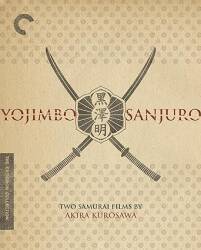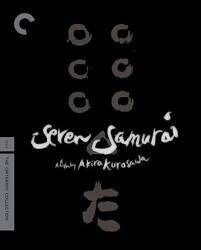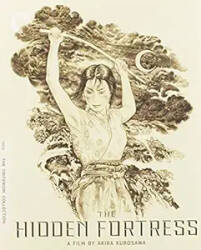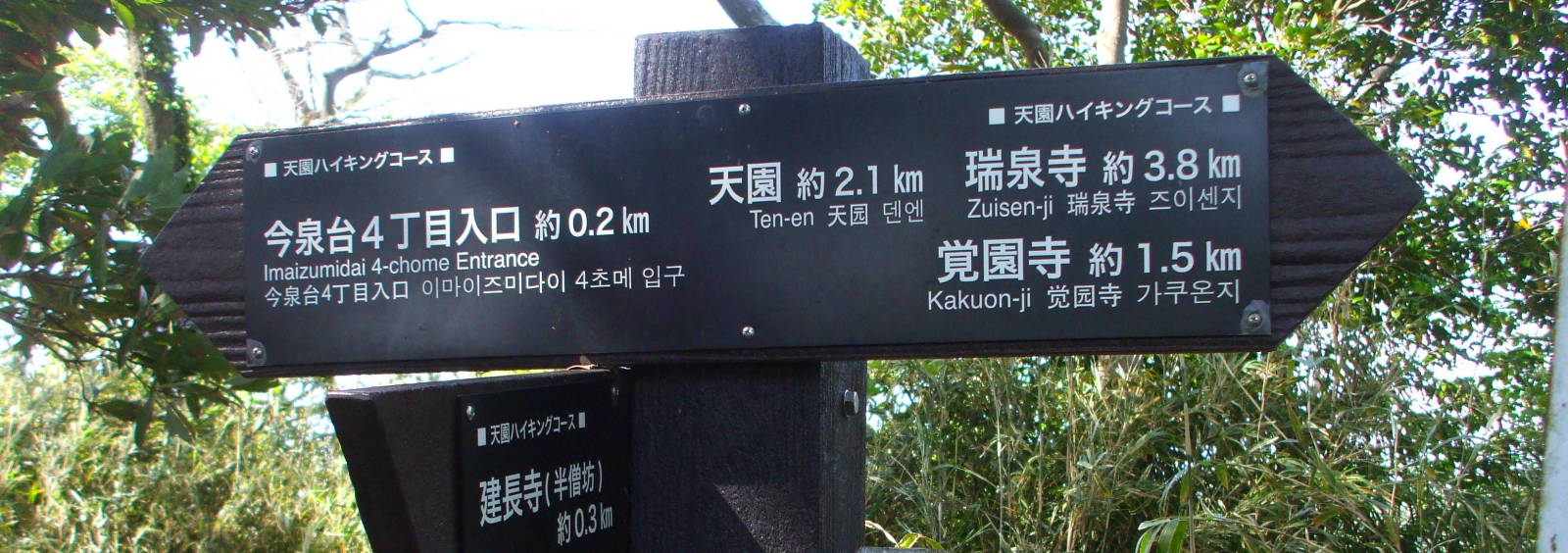
Yagura, Stone-Carved Tombs
The Path Around Kamakura
Kenchō-ji and the "Five Great Mountains and Ten Monasteries System"We have just visited Kenchō-ji, the First Rank of Kamakura's "Great Mountain" Zen temples. Now we will follow a path along the ridgeline that was medieval Kamakura's natural defensive ring. Along the way we will see several yagura, stone-carved tombs from the time of the Kamakura Shōgunate and earlier.
Japan's "Five Great Mountains and Ten Monasteries System" was based on the earlier system established in China. It established five major Zen Buddhist temples in Kyōto and five in Kamakura. Below those were hierarchies of subsidiary temples across Japan. While they were ostensibly dedicated to supporting the Rinzai sect of Zen Buddhism, they became a government bureaucracy.
The Emperor was based in Kyōto, and while Shintō maintained that the Emperors were descendants of the gods, their power was mostly symbolic. The Shōgun was the real ruler of Japan. The temple network gave nation-wide control to the Shōgunate based in Kamakura.
Kenchō-ji was the First Rank of Kamakura's Zen temples. So, it was effectively the source of government bureaucratic power nation-wide.
Buddhism and Shintō
We entered the Kenchō-ji temple complex from the southwest, near the highway and rail line leading down to Kamakura. We passed through the sōmon, or outer gate, and then through the sanmon or sangedatsumon, the "Gate of Three Liberations". That's the main gate leading to the Butsu-den, the main Buddha Hall. These mark, from a Buddhist perspective, passages into increasingly sacred space.
Below, we have reached the farthest back area of the Buddhist temple complex, and we are approaching a Shintō shrine at the top of the slope ahead. Those are torii, Shintō gates in front of us. We will pass through them, marking passage into increasingly sacred space from a Shintō perspective.
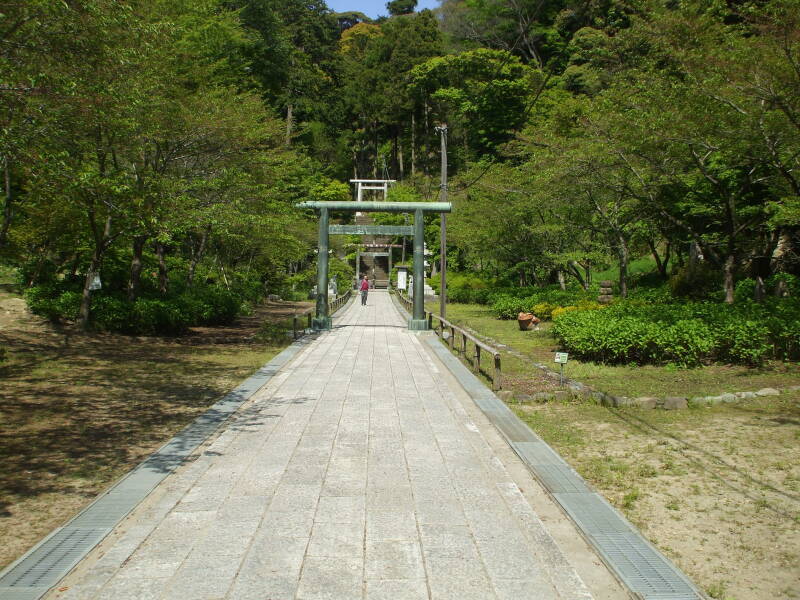
Shintō and Buddhism are very much blended in Japan, along with aspects of Confucianism.
Shintō appealed to the Emperor. Well, of course it did, it said that he was a descendent of the gods if not actually a god himself. (depending on just exactly what you mean by the word "god", which is hard to pin down)
Buddhism, and especially Zen Buddhism, appealed to the samurai warriors and the Shōgun war lords. They appreciated Zen's philosophy and the presence of warrior gods like Hachiman.
Shintō andBuddhism in
Japan
Shintō developed out of the prehistoric animist traditions of the Japanese archipelago. Buddhism was imported from China via Korea to Japan in 552 CE. Before long, Shinbutsu-shūgō had developed. That was the idea that Shintō and Buddhism could be true simultaneously. It held that Shintō kami or local spirits or deities could actually be Buddhas or Bodhisattvas manifesting in forms that the local people perceived as Shintō kami.
Before long every ji had a gū and every gū had a ji. That is, every Buddhist temple complex contained a Shintō shrine, and vice-versa.
The Emperor regained power with the Meiji Restoration of 1868. The sweeping changes included the shinbutsu bunri, the forcible separation of the two spiritual traditions. Well, "separation" was the formal theory. The Emperor had just retaken power from the warlords after centuries of being a figurehead. Shintō was associated with the Emperor, Buddhism with the Shōgun and samurai. The result was mainly a violent anti-Buddhist movement, closing thousands of temples and confiscating the land for the Emperor.
State Shintō,more or less
The new emphasis on pure Shintō included its doctrine of deified Emperors. The U.S. called this "State Shintō" during World War II and the following occupation, although no one in Japan called it that. With Japan's surrender and the postwar occupation ending any official view of a divine Emperor, the Shintō-Buddhism separation was relaxed and you again see shrines within temple complexes, temples within shrine complexes, and all sorts of blending.
CrucifiedSanta
Meanwhile, Santa Claus nailed to a cross in Japan seems to be an urban legend dating to the late 1980s into the very early 1990s, when the Japanese economy was booming (dangerously so, as it turned out) and iconic U.S. real estate was being purchased by Japanese firms. Americans were thoroughly freaked out by these wealthy foreigners, who must be up to all sorts of nefarious mischief. So, the Americans made stuff up.
Enough with the armchair Joseph Campbell. Time to climb lots of steps.
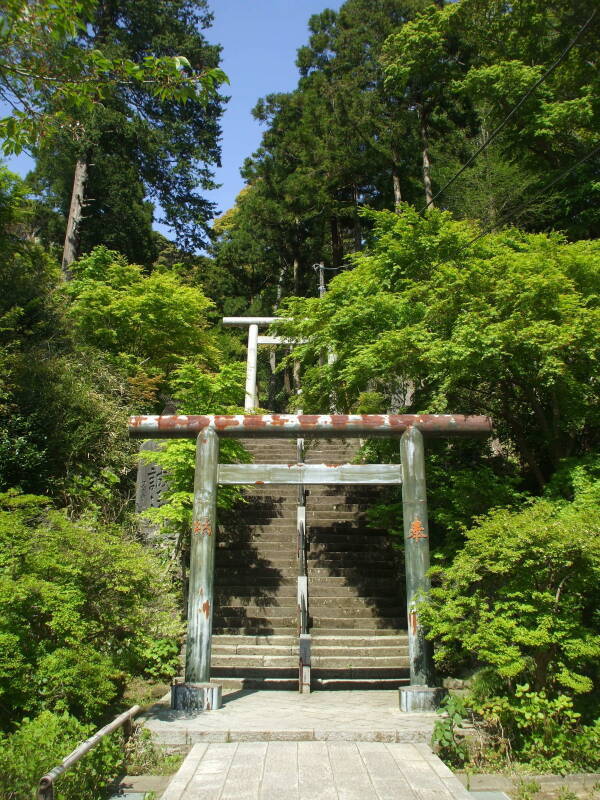
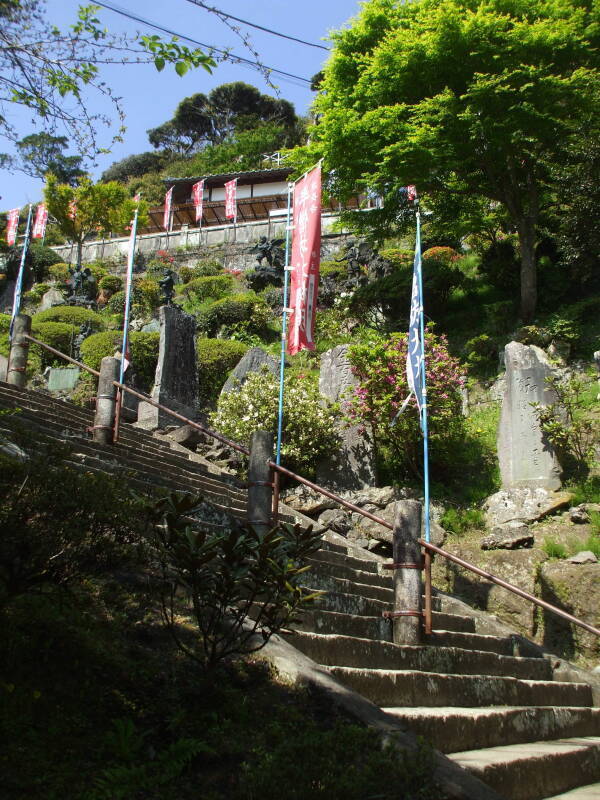
The steps lead up to Hansōbō Shrine. This is the Kenchō-ji temple's large protective Shintō shrine. The enshrined kami or spirit is Hansōbō Daigongen.
Gongen is the term for a manifestation of a Buddha in the form of an indigenous kami. This concept is the core of the honji suijaku theory, in which Buddhist deities appear to the Japanese as native kami or Shintō spirits. It relies on a specific interpretation of the Mahayana Buddhist concept of upaya or "expedient means". This is shinbutsu-shūgō, the syncretism of kami and Buddha.
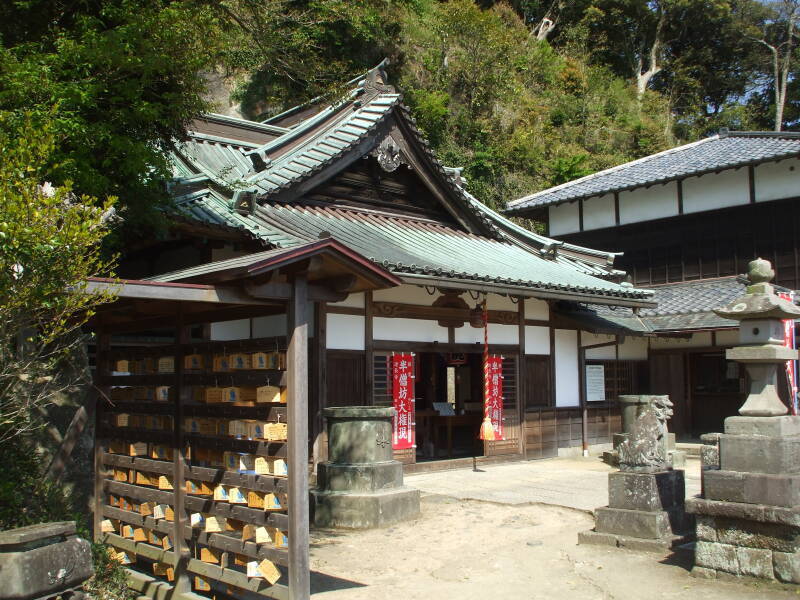
in Asakusa
If all this exotic syncretism bothers you, remember the Roman Catholic discovery that Chinese Buddhist representations of the bodhisattva Guanyin remind them of the Virgin Mary, and therefore that must be "expedient means" revealing the One True Faith.
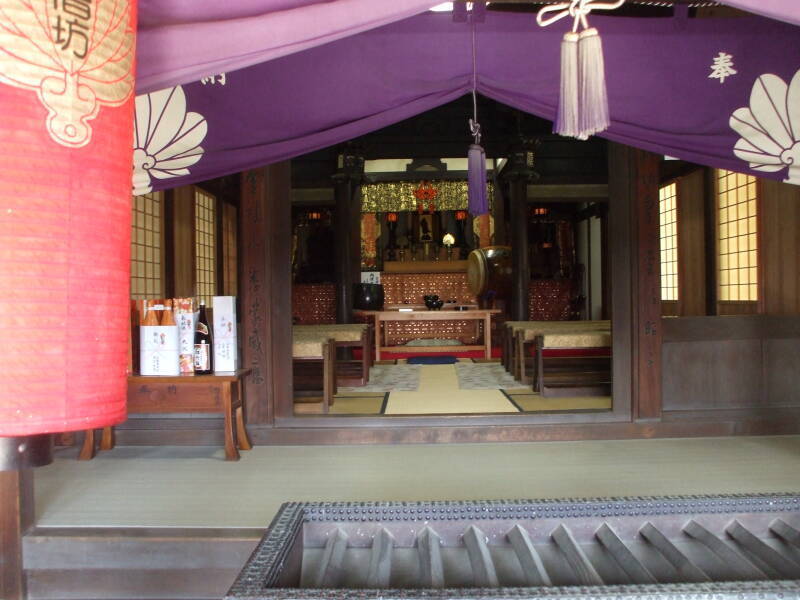
Just above the shrine is Kaushun-in temple, which houses a statue of the Bosatsu (or Bodhisattva) Monju.
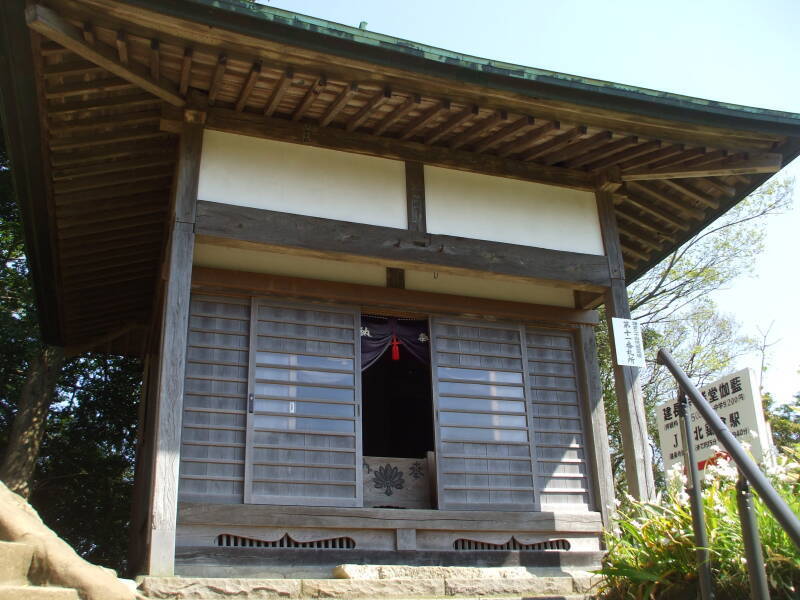
So, the Buddhist temple complex Kenchō-ji contains the Shintō Hansōbō Shrine, which in turn contains the Buddhist temple Kaushun-in. Buddhism inside Shintō inside Buddhism.
Bosatsu Monju (or Bodhisattva Mañjuśrī in Sanskrit) is associated with prajñā or insight. Monju is one of the oldest and most significant bodhisattva in Mahāyāna literature. He is typically depicted with a flaming sword or scepter in his right hand, representing the realization of transcendent wisdom which cuts through ignorance and duality.
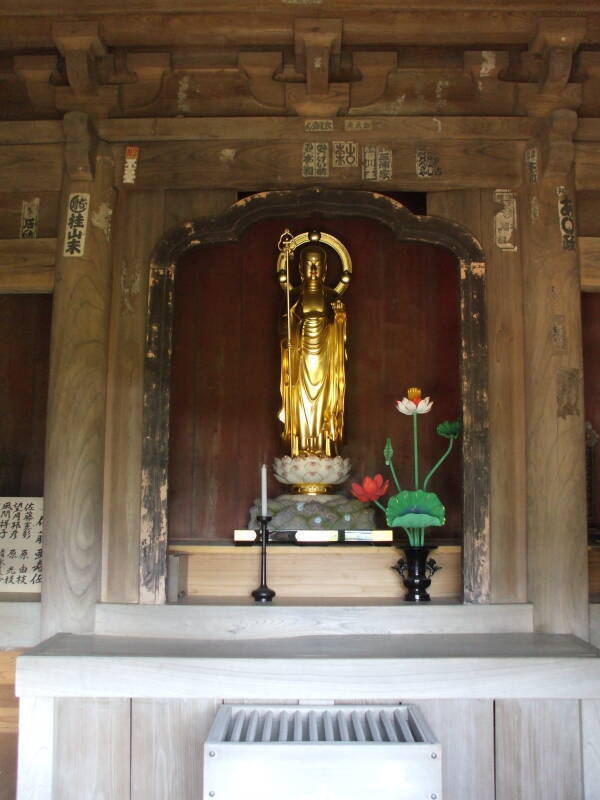
I could use a flaming sword to cut through the theological confusion right about now.
The statues along the stairs leading to Hansōbō Shrine represent Tengu. The Tengu are goblin-like creatures which accompany the gongen. Some have wings and a beak, they are called Karasu-tengu or "crow tengu".
In the first picture below we're at the Bosatsu Monju Kaushun-in temple looking down over the Tengu statues toward the Kenchō-ji temple complex.
In the second, more stairs continue up.
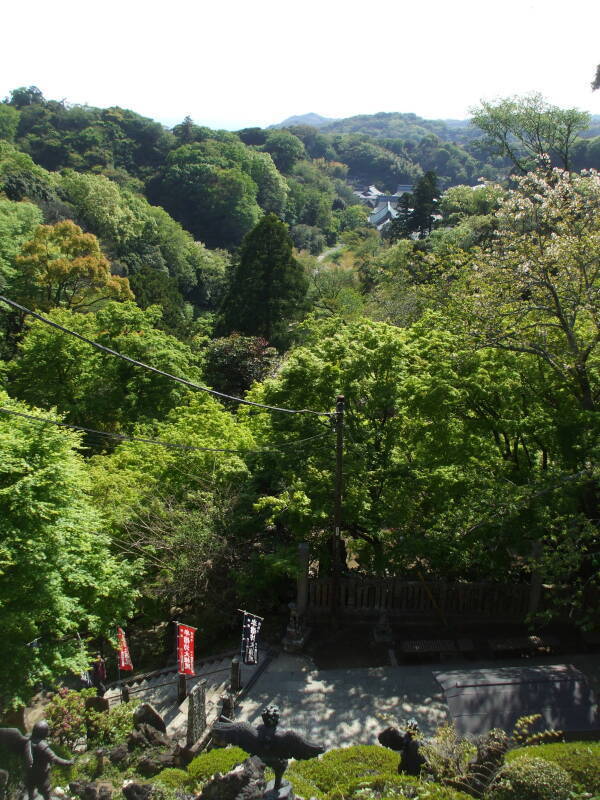
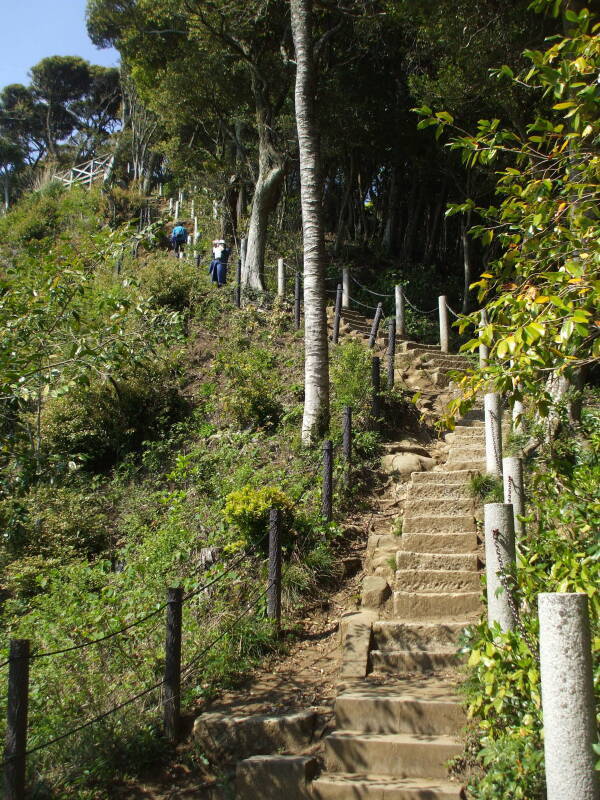
You eventually reach the lookout point at the top of the ridge. We're looking southwest, to the city of Kamakura and Sagami-wan or Sagami Bay. We can see how the ridge surrounds Kamakura. Only a few narrow and easily defended openings lead to the city by land.
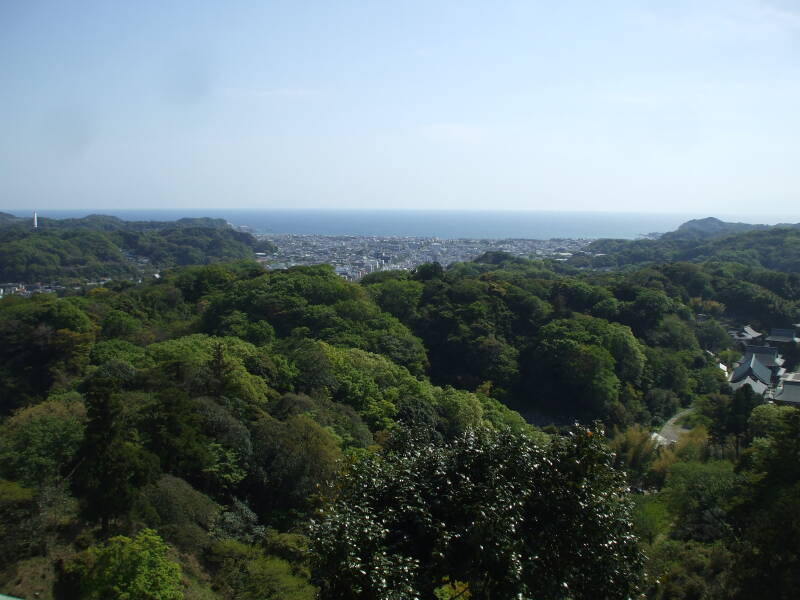
...and the view to the west...
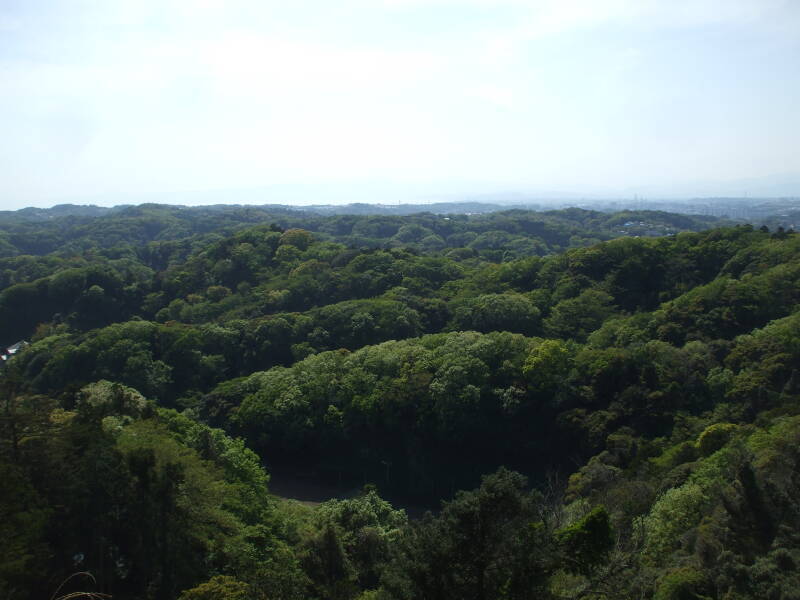
...and to the northwest. Fuji-san is visible on some days. Not today.
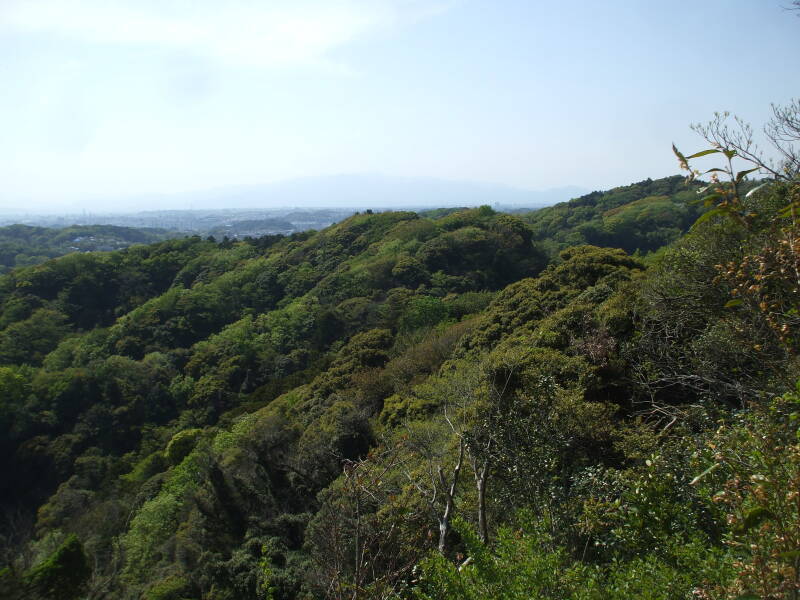
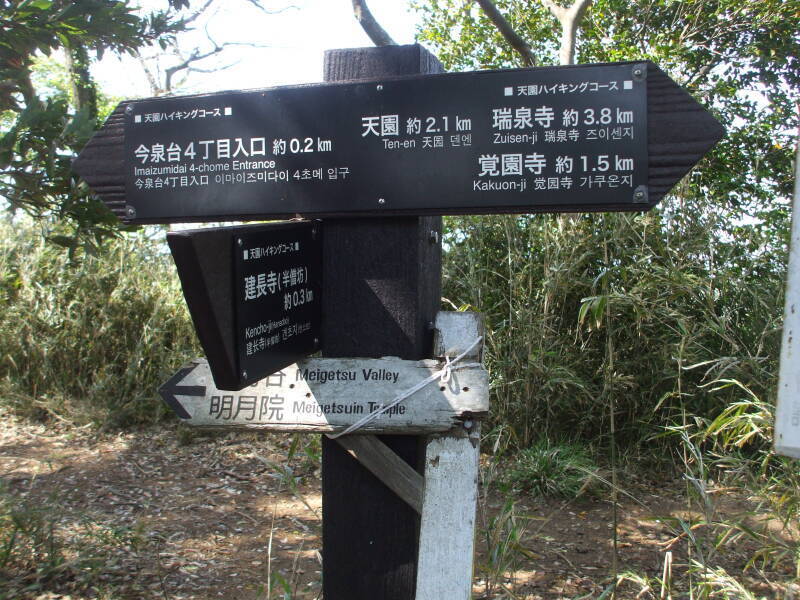
Here we go onto the path! We're going east, clockwise along the ridgeline around Kamakura.
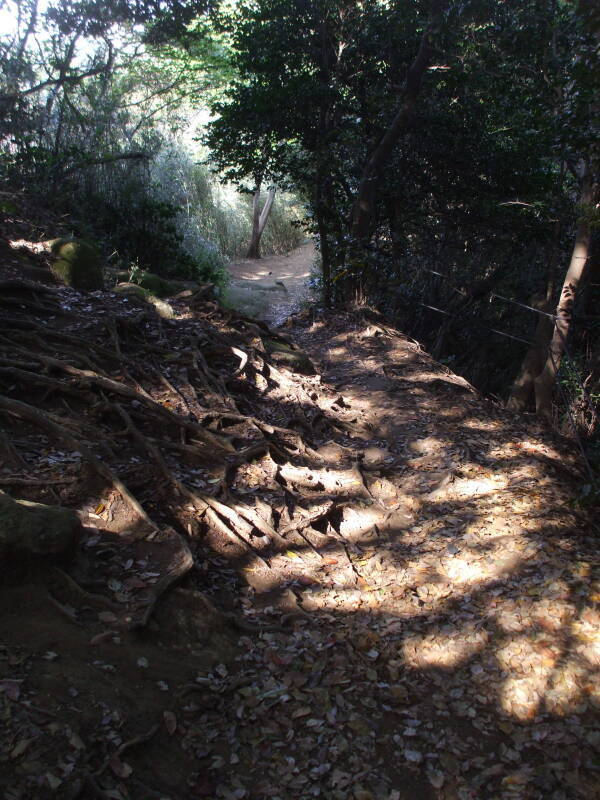
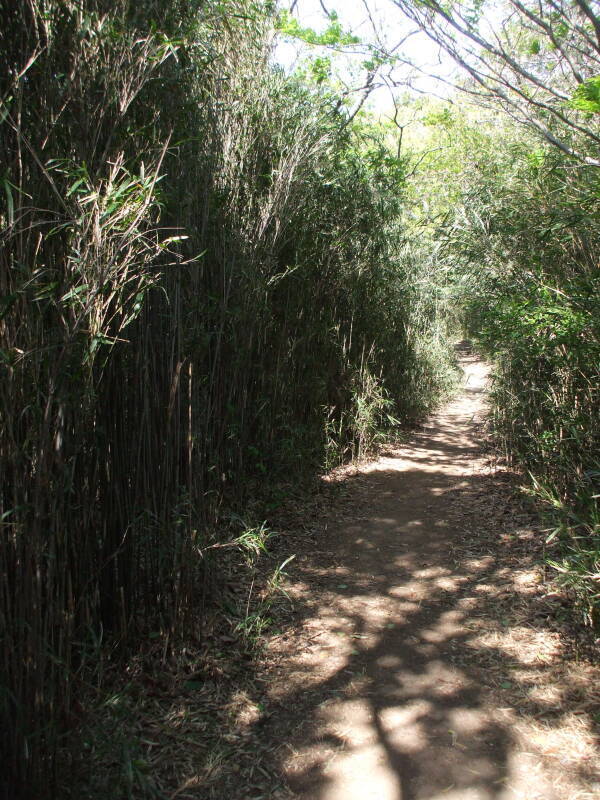
Yagura — やぐら
Yagura are cave tombs. They are dug into the soft sandstone forming the hills around Kamakura. Current estimates range from 1,500 to over 5,000 yagura remaining, with untold others destroyed or eroded away.
There isn't any evidence from archaeology or history as to when or why the yagura began to be dug. They were probably used as tombs originally, and later functioned as cenotaphs, empty tombs or monuments that don't contain actual remains. A few have a stele or a gorintō bearing some dateable reference. The oldest such one dates to between 1260 and 1270 CE.
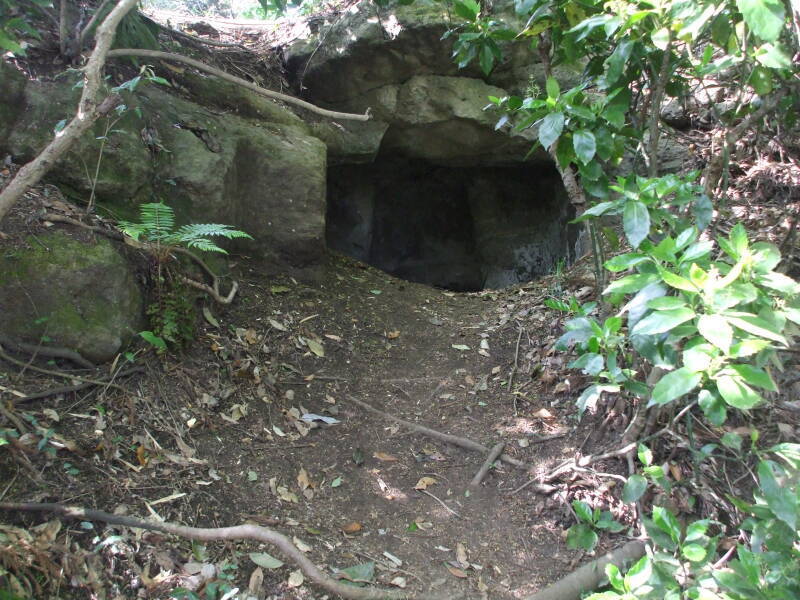
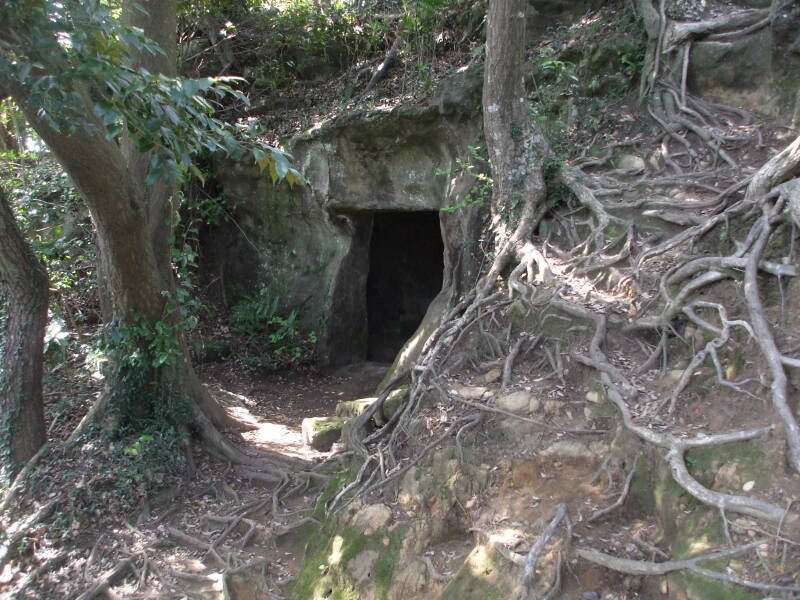
A yagura may be little more than a recess cut into a rock face. More elaborate ones may have a short corridor leading to a roughly rectangular crypt. There may be a small recess cut into the floor to accept ash and bone fragments from a cremation. But usually an urn would be placed in the chamber. A full body burial wouldn't be practical as the floor is bedrock.
There has been a theory that a law forbidding cemeteries in towns may have led to the use of yagura. Or maybe it was that there wasn't much free space in Kamakura, so it was simply a practical solution.
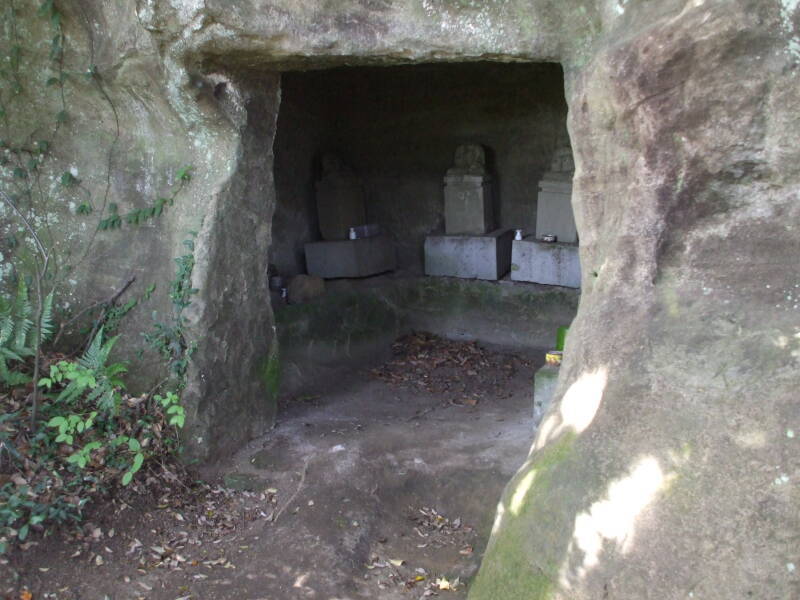
The yagura were originally created for the samurai class. Some are for other high-ranking priests and artisans.
Some had wooden doors closing their entrance. Some had paintings imitating the ceilings of temples.
Yagura remained in use after the fall of the Kamakura Shōgunate for at least a little over a century, into the mid 1400s. Their use declined after then. Some were converted into storage facilities. Others were re-used as graves, filled in with soil.
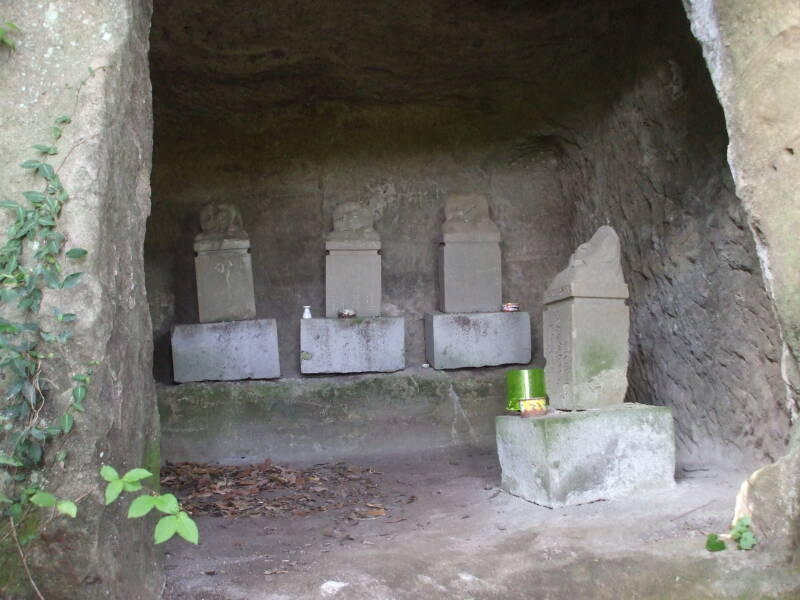
People still use centuries-old yagura as memorials. There may be a stele, a statue, or a gorintō. Or maybe just offerings: coffee, soft drinks, candy. I expect the informal memorials to be a mix, in honoring dead family or friends, Buddhist deities, or Shintō kami.
The Buddhist gorintō or Five-Ringed Tower is a stone form of pagoda or grave marker. Its five segments represent the Buddhist cosmology. They form the body of the cosmic Buddha Mahāvairocana, our own bodies, and the physical world. Jewel-shape or Space is at the top, cube or Earth is at the bottom. The five elements plus wisdom make up the universe. The elements are not destroyed at death, and so it is possible to join with Mahāvairocana.
| Shape | Represents | Sanskrit | Japanese |
| Jewel-shape | Space | ख / kha | kuurin |
| Hemisphere | Air | ह / ha | fuurin |
| Pyramid | Fire | फ / fa | karin |
| Sphere | Water | व / va | suirin |
| Cube | Earth | अ / a | chirin |
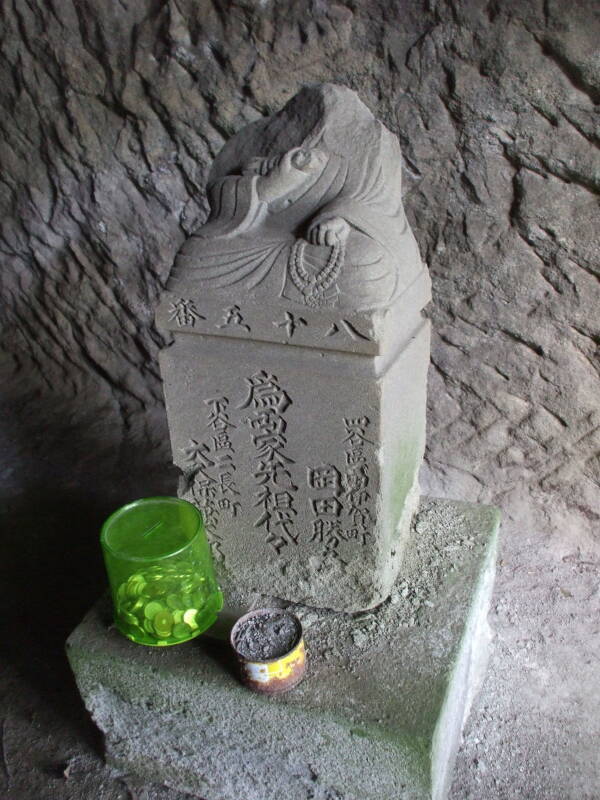
The green plastic container contains coins. Many are ¥1 coins, small and lightweight, made of aluminum. Others are ¥5 coins, which are more auspicious as they have a central hole.
Back in the time when yagura were used, "funeral" referred to processing the body. The funeral was the day that the body was cremated. The ashes were interred and a memorial was erected later. Any associated ceremony was not part of the funeral.
The path follows the ridgeline, and there is a lot of up and down as you go around Kamakura. The town has rigged ropes to help you get up and down a few of the steeper places. There are steps, but they are heavily worn.


You will probably pass other people walking along the paths through the hills.
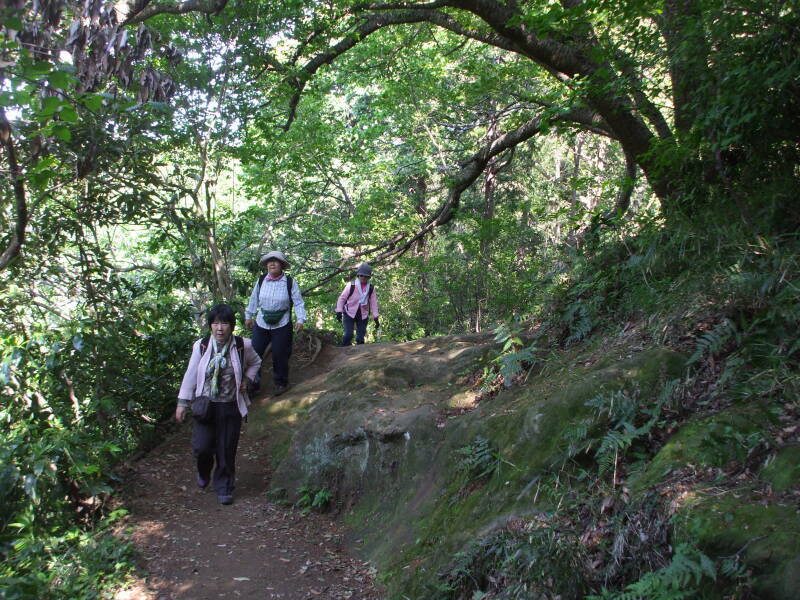
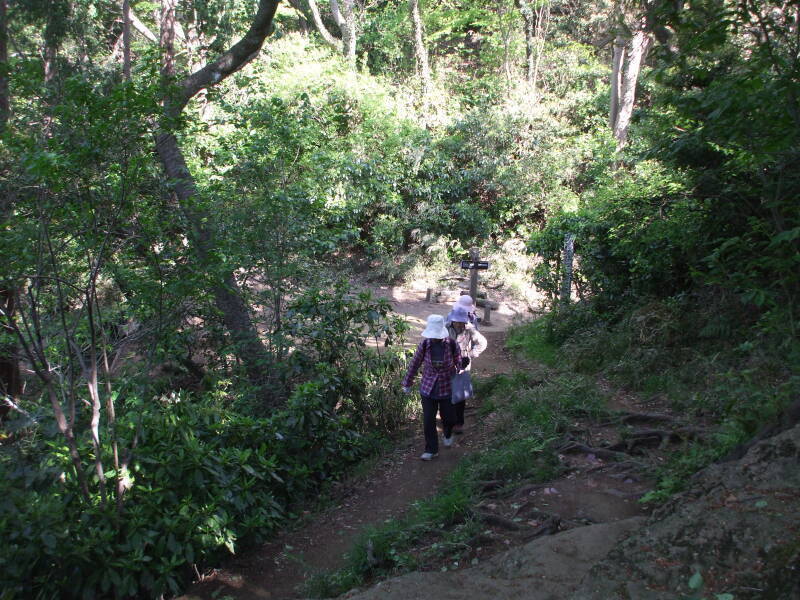
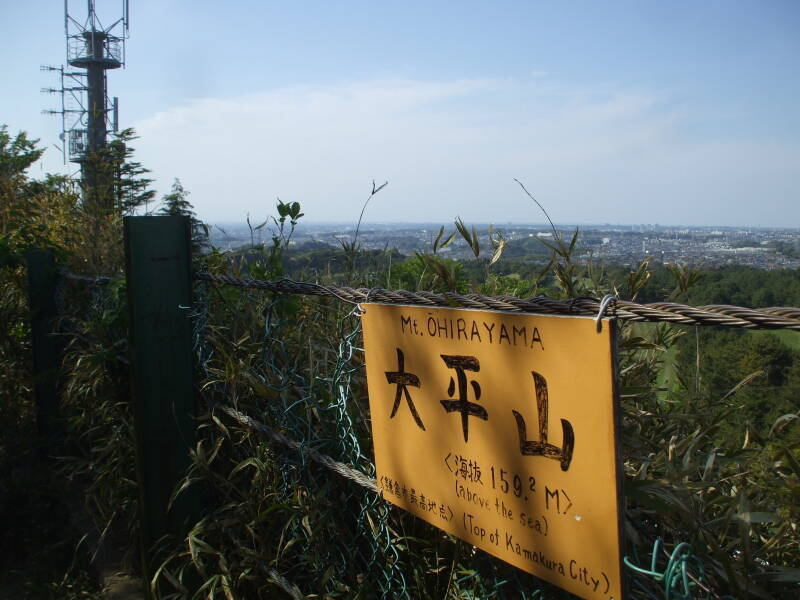
Then all at once, the path that has been running through the forest comes out into an opening at a high point. You're looking out to the north over a golf course, with the tallest buildings of Yokohama visible in the distance.
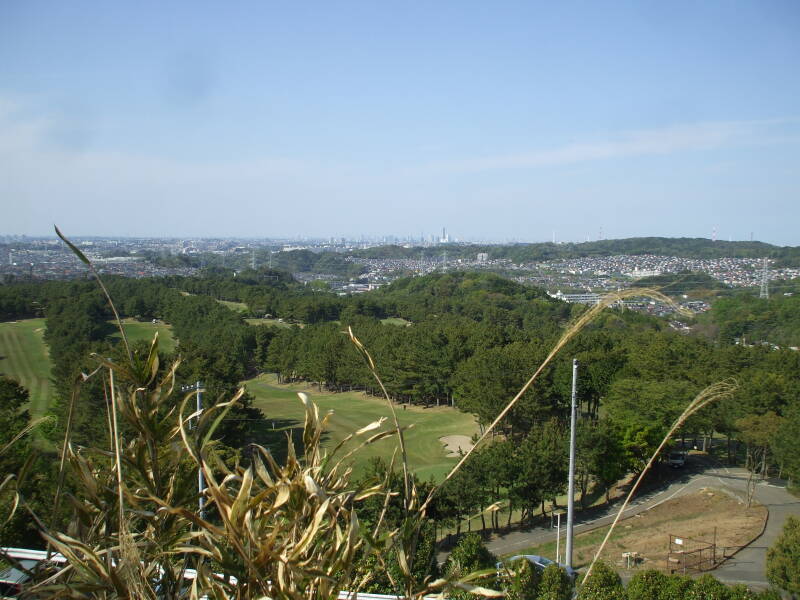
To the south we still see Kamakura and Sagami Bay.
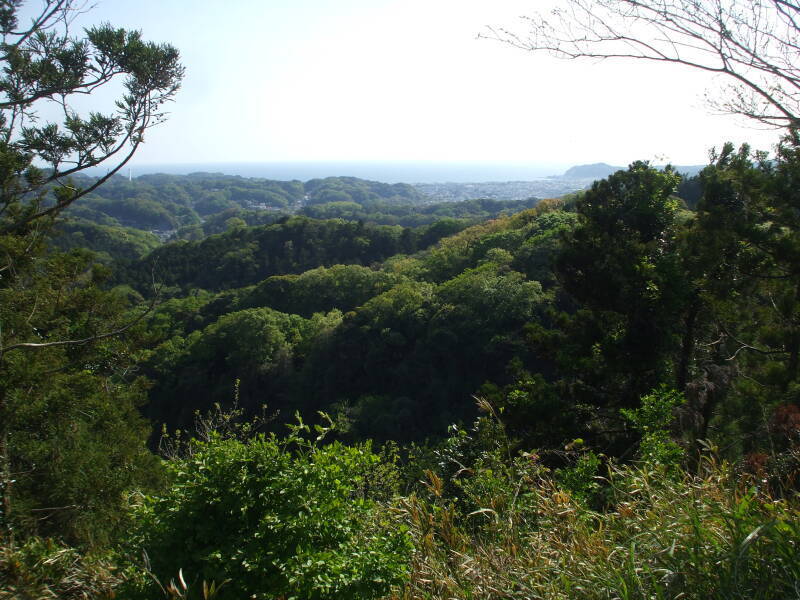
Then it's back into the woods and more informal memorials and ancient yagura.
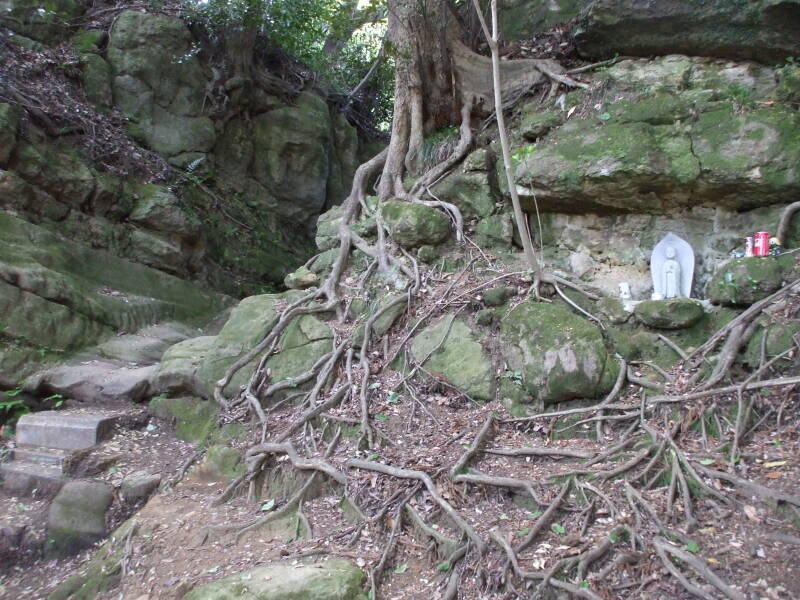
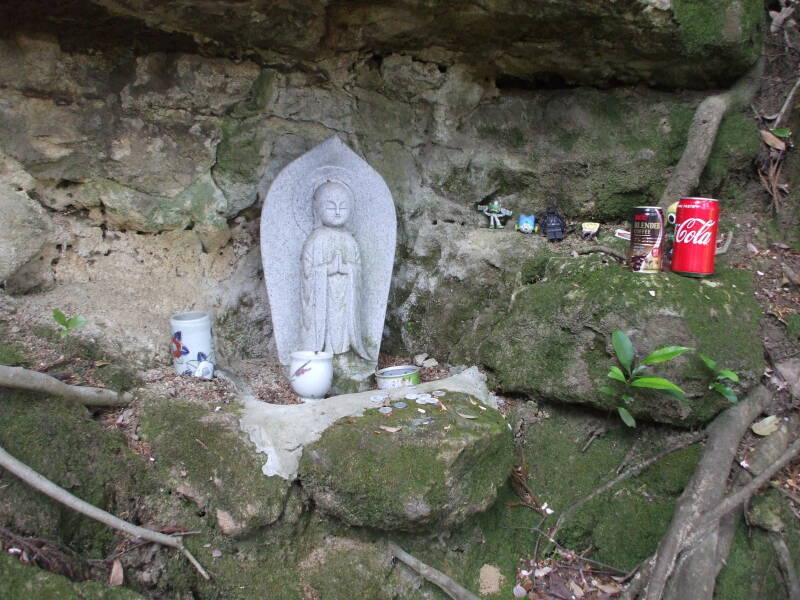
Some yagura are isolated, others are in groups. One group near Kamakura contains 180 to 200 individual caves.



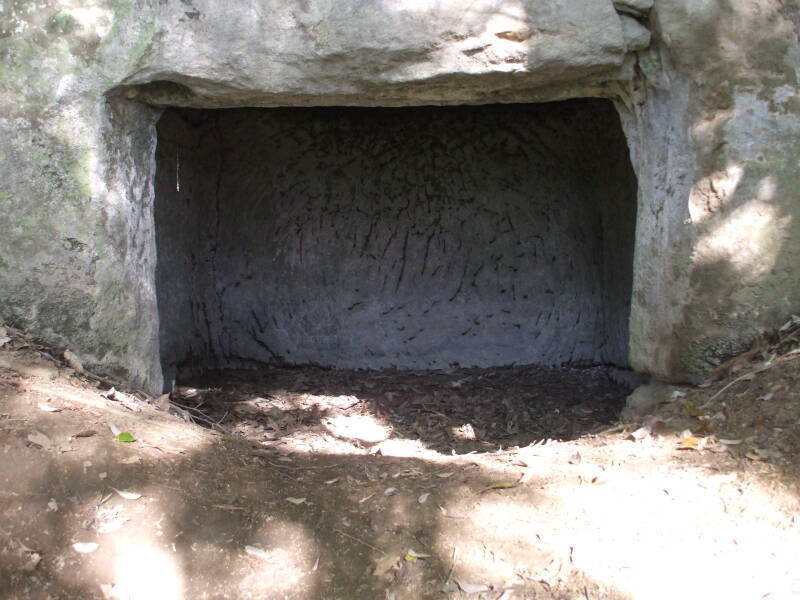

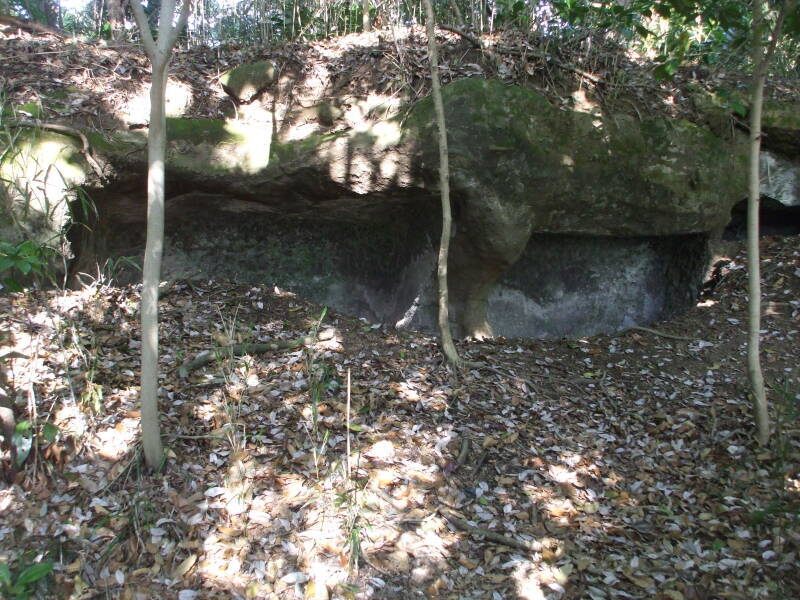
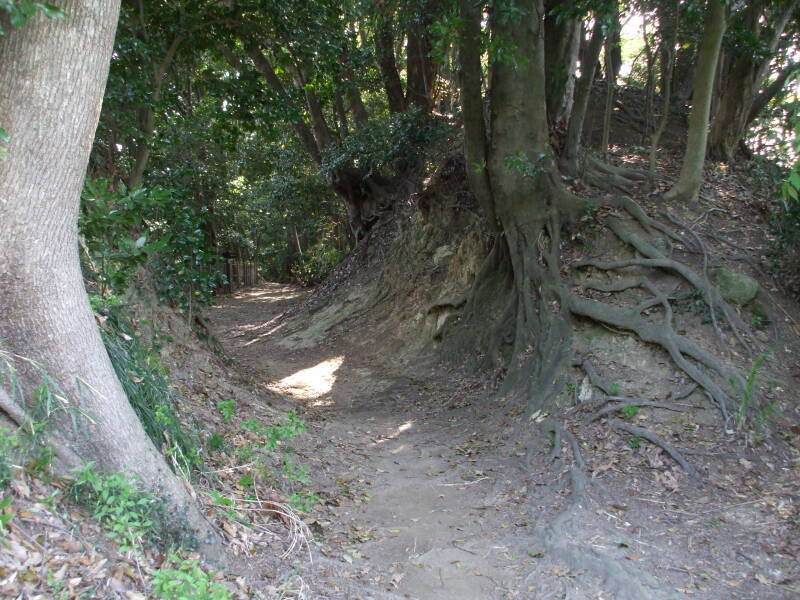
This one has a partial gorintō. Space or Jewel-shape is at the top, Earth or Cube is at the bottom. I'm not sure if the next-to-top is Air or Hemisphere, or if that's Water or Sphere. Fire or Pyramid seems to be completely missing.
There is a small set of Buddhist figures, an incense burner, a plastic box, and some flowers.
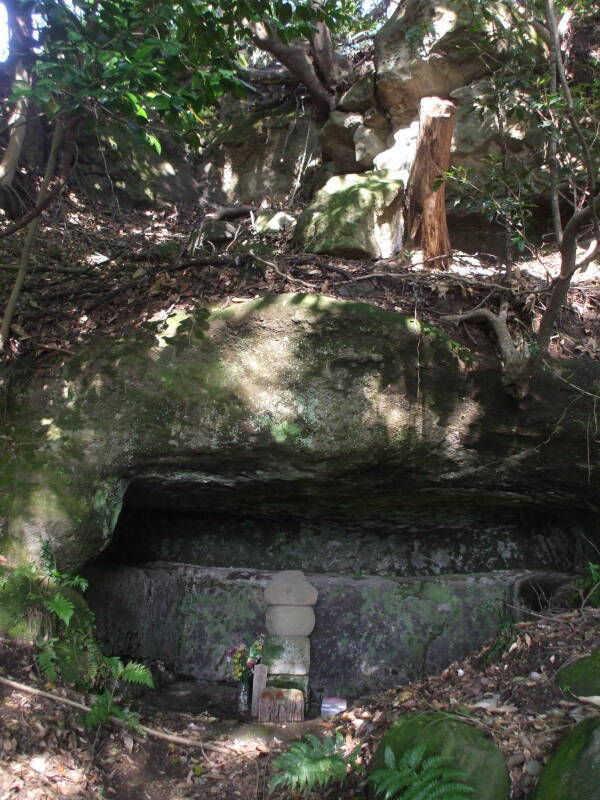

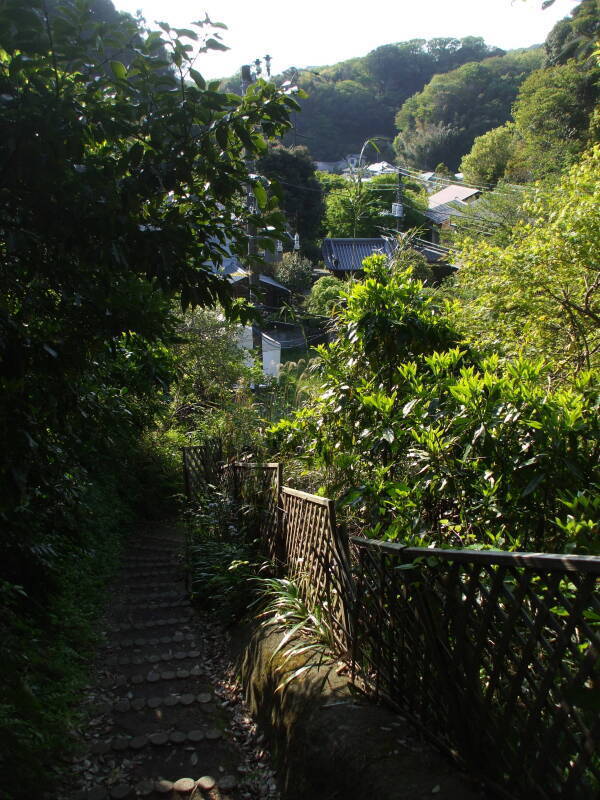
You can continue along the ridgeline to where it goes down to the sea. Maybe you want to throw in a sword and see if the Sea Goddess pulls the water back from the beach. I don't think that would work for me, so I have taken a path leading down to the eastern edge of town.
Kinpeizan Temple
I'll just quote from an explanatory sign here:
As the family temple of the head of the representatives
of Kanto region of the Muromachi Shōgunate,
this temple is one of the 10 most important temples
in the Kanto region, second only to the Kamakura's
five principle temples of Zen sect.
The temple's honorary mountain name, Kinpeizan, is said
to be derived from the autumn colors that adorn the
mountains surrounding the temple, which are as beautiful
as a brocade-covered folding screen.
In additino, a great variety of flowers can be enjoyed
in the temple grounds throughout the four seasons.
The founding priest, Muso Kokushi, was an important priest
of the Zen sect during the Kamakura and Nanbokucho periods
(A.D. 14th), responsible for the deep devotion of both
the Emperor Godaigo and Ashikaga Takauji.
His talent as a garden designer is evident in the
garden he developed to the rear of the temple,
which was excavated and restored in 1970 and is
specified as a national place of scenic beauty.
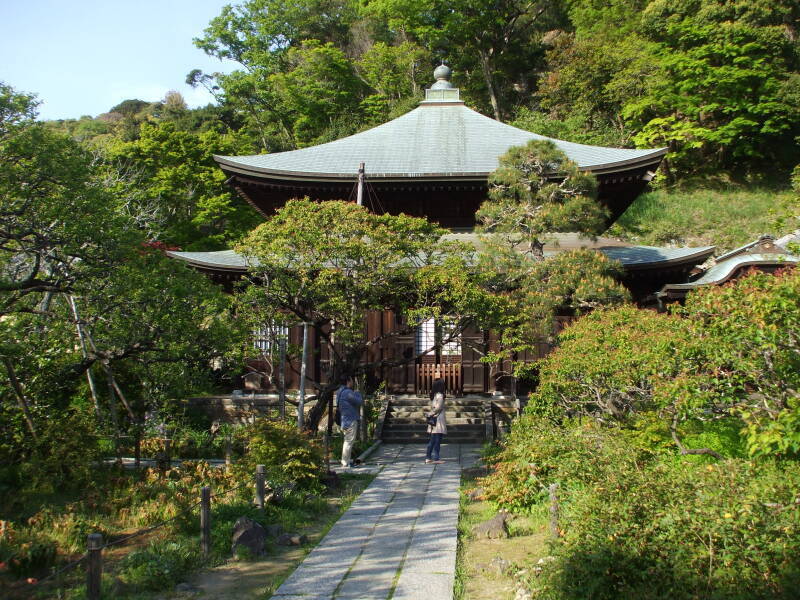
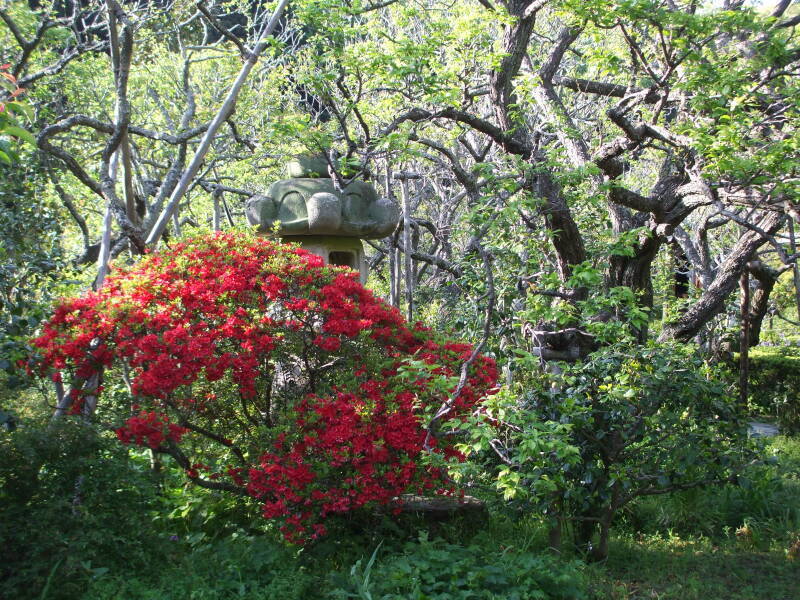
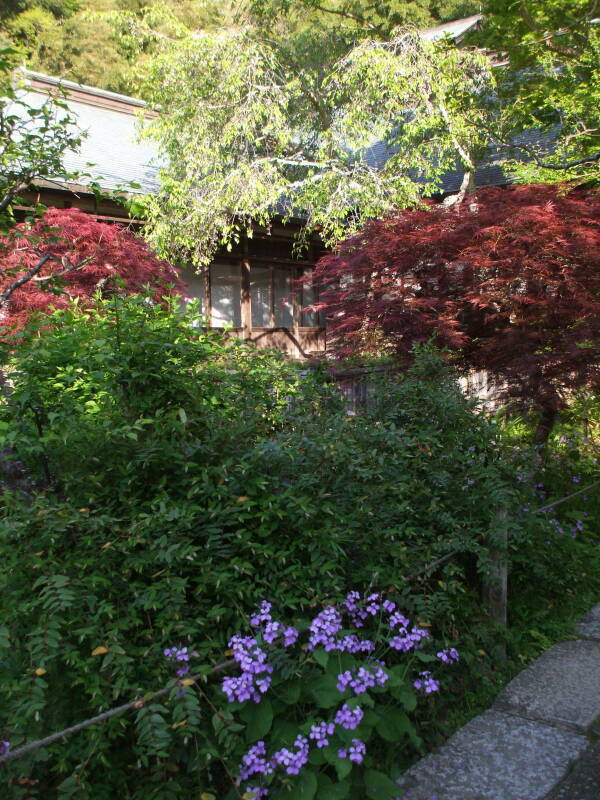

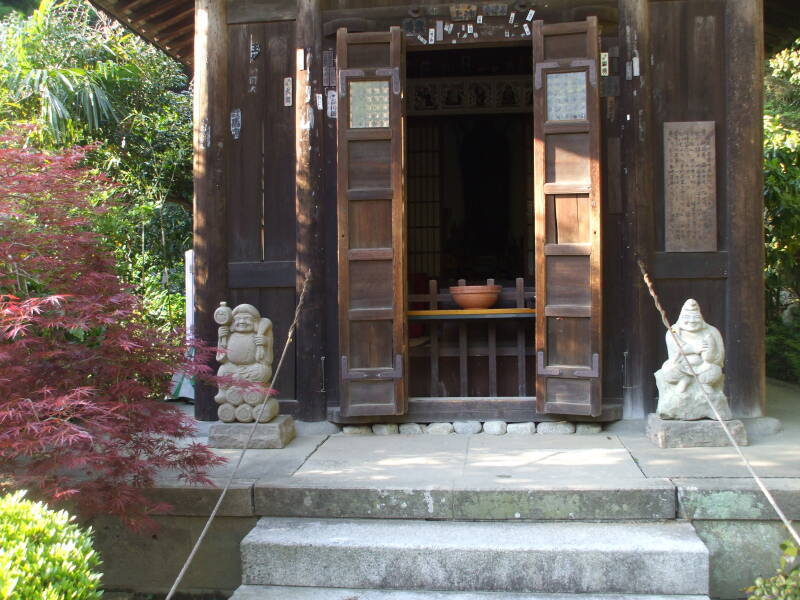
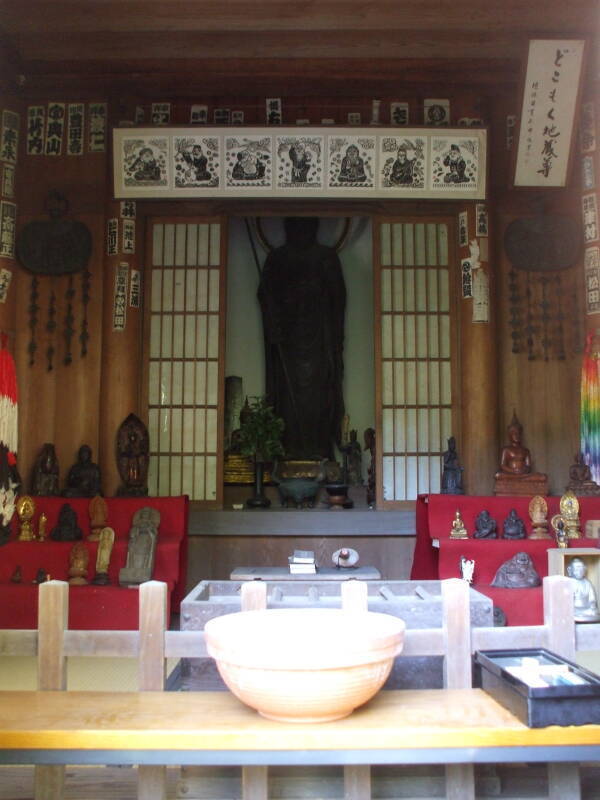
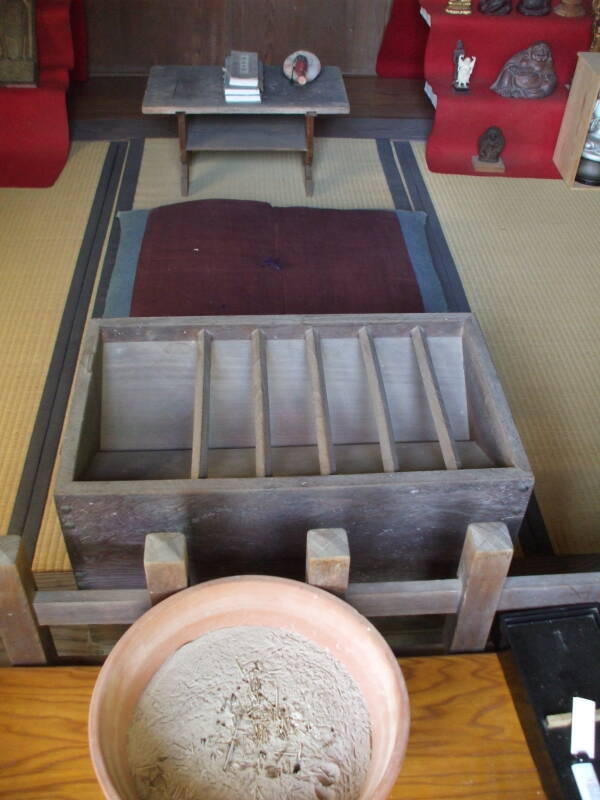

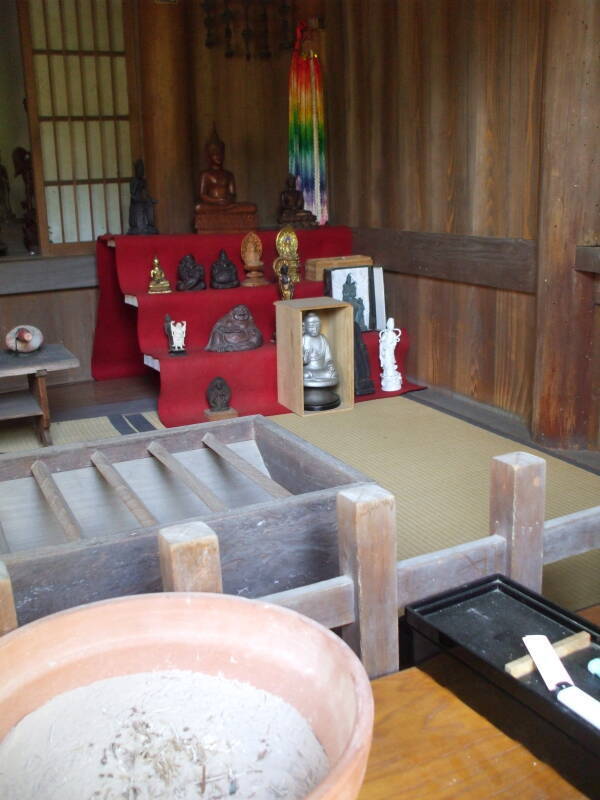
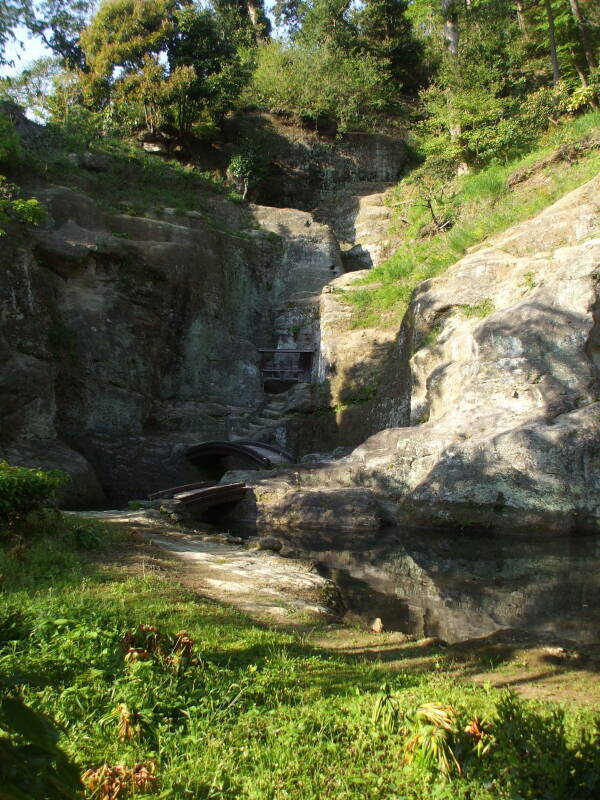
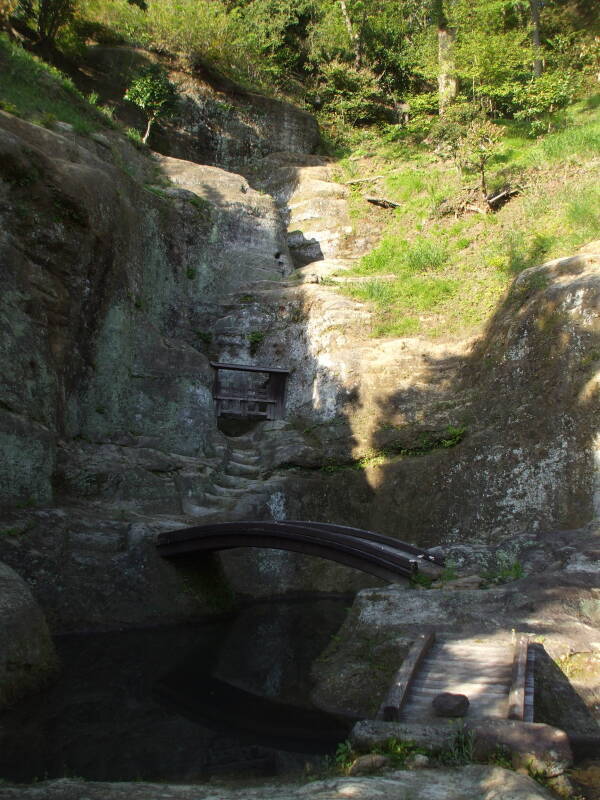
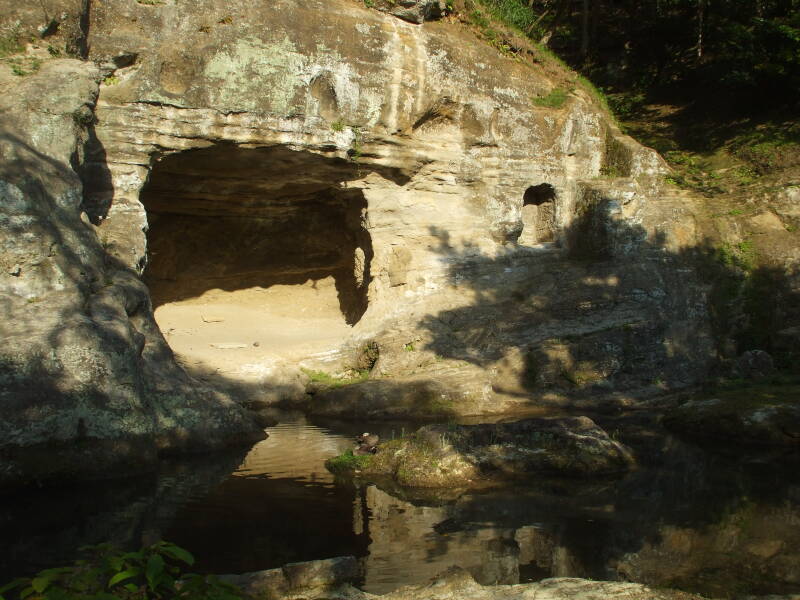
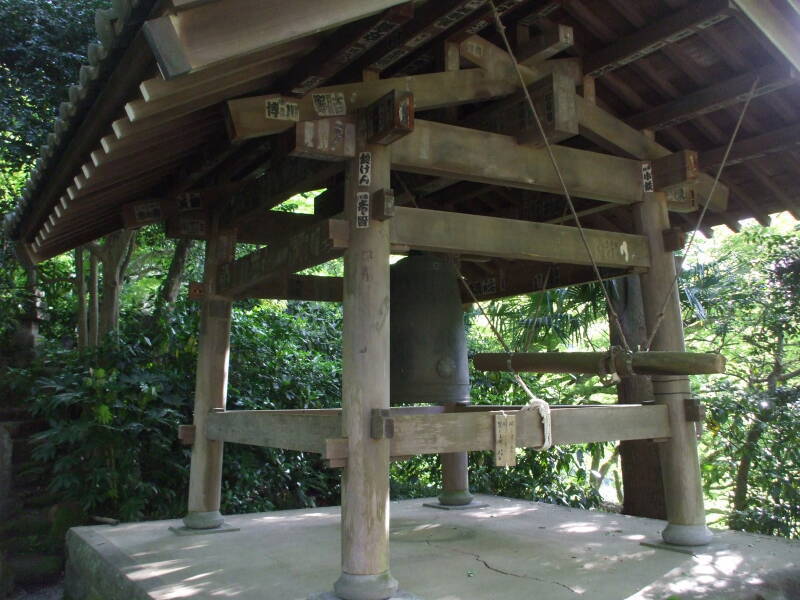
Next: Daibutsu, the Great Buddha » Or your choice:
The above is specific to Kamakura. Or maybe you want to explore other places in Japan.
Other topics in Japan:
